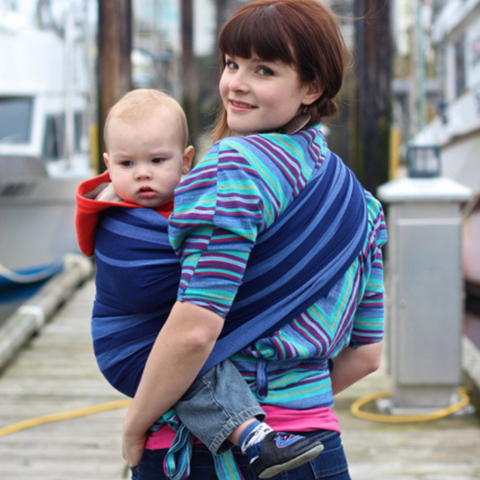There are 3 ways to carry your baby: on the stomach, on the back and on the hip. The best position is the one that will ensure a good comfort for the baby and the carrier and that will respect the baby's physiology and needs. Ready to discover the advantages and disadvantages of each position in order to choose the one you need?
ON THE BELLY:
The most reassuring position
Advantages:
- This position is very reassuring for the newborn. It offers him a reassuring proximity with his parent. The visual contact is very comforting during the first 3 months of baby's life.
- Thanks to the proximity with baby, it is easier to respond quickly to his needs.
- This position is very practical during breastfeeding.
Pictured: A dad with the Trek Air-O baby carrier, color Black + Aqua.
Cons:
- Carrying on your stomach can be very cumbersome. The movements of the body are then limited by the presence of the baby.
- This position requires a lot of vigilance on the part of the parent who must watch that the baby's head is well supported at all times.
- arrying on the belly will become more and more difficult as the baby grows. The baby will take up more space and his movements will be more and more lively.
Tips:
Bellywearing is perfect for newborns because it is very secure and it is easy to respond quickly to their needs. However, as the baby grows, this position becomes less ideal. It is then preferable to opt for a position on the hip or even better, on the back.
Our belly carrying demonstrations are available here: watch the videos. The Trek Air-O, Multi 2.0, PöpNgo and EvöAir baby carriers allow for a belly carry, as well as the woven baby wraps and the adjustable sling (Ring Sling).
ON THE HIP:
A compromise between closeness and freedom of movement

Advantages:
- Carrying on the hip allows you to keep an eye on your baby and to be close to him.
- It allows for more freedom of movement than a belly carry.
Cons:
- On the downside, all hip positions cause an asymmetrical load, so they are less comfortable for longer periods of time.
Pictured: A mom walks around with an adjustable sling (Ring Sling).
Tips:
Wearing on the hip with an adjustable sling with rings (Ring Sling) is the most convenient and easy, as well as being very comfortable. All slings, the Mei Tai and Chimparoo structured baby carriers also allow this position.
ON THE BACK:
The position for maximum wearer comfort
Advantages:
- Carrying on the back allows maximum freedom of movement and optimal comfort for the wearer.
- It also allows an ideal distribution of the weight on the body of the carrier for a better comfort, especially when it is a bigger and heavier child. This position is perfect for long rides and hikes.
- The child also benefits from the backpack, which places him in a natural physiological position and in the right direction of walking, the same as that of the carrier. The child's field of vision is larger, allowing him to enjoy many sensations and stimulations. With his curiosity aroused, the little one participates in daily life, whether at home or outside.
- When the weather is hot, carrying on the back is the best option because it allows the child to have his shoulders free and to benefit from a little coolness.
Pictured: Apple picking with the PöpNgo baby carrier.
Disadvantages:
- This position can be a little stressful for the parent new to babywearing because they can't see the child easily and make sure they are positioned properly. It requires some practice.
- It is more difficult to meet the immediate needs of the child.
Tips: With a backpack, the child is behind you, and you cannot see him/her properly to check his/her condition. It is recommended to wait until your little one is perfectly capable of going from lying down to sitting up on his own before starting to carry on the back. This ability to hold the head, neck and torso steady usually occurs between four and six months.
Carriers who are familiar with back carriers will tell you that it is possible to carry an infant on the back without any problems. To do so safely, it is important to master the carrying method used.
*******************
Don't forget: the best position is the one that ensures maximum comfort for you and your baby, the one that respects the baby's physiological development and the one you feel most comfortable with.
On our YouTube channel and our Frequently Asked Questions page, you will find very interesting resources to develop your babywearing practice. You can also contact us here.




Share:
7 Criteria to Choose Your Baby Carrier or Wrap
5 tips for safe babywearing